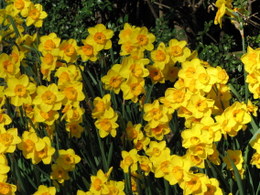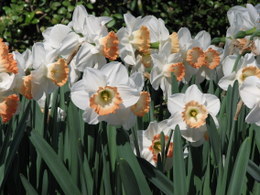Daffodil Growing Guide
Daffodil (Narcissus spp.) is a perennial native to southern Europe and North Africa and will do well in USDA Zones 4 to 9. The bulbs are planted in the fall with bloom times from mid-spring to late-spring.
There are varieties ranging from 9 to 18-inches high and spread 4 to 6-inches wide, with colors of yellow, white, orange and pink.
In addition to being deer and squirrel resistant they are a welcome sight in the spring time.
The best time to buy the bulbs is when they show up in the garden centers. You can then store them properly in a cool dark location so that the bulbs will be at their best when you plant them.
Soil Preparation
Plant your bulbs in full sun to part sun in a nice loose well-drained garden soil. They will do best in a slightly acid soil with a pH range of 6.0 to 7.0. The bulbs may rot if the soil is too wet.
When to Plant
They should be planted in the fall after the first frost, but before the ground freezes. A good time is when the soil temperature drops below 60-degrees F. The bulb needs a period of time to develop a good root system before the ground freezes. In most areas this will be around the end of October or early November.
Planting Daffodils
Follow the grower’s instructions. In general plant the bulbs 6 to 8-inches deep and 6-inches apart. For the best visual affect plant the bulbs in groups of 3 or 5.
When planting the bulbs, place the bulb with the pointed end up. After planting the bulbs, cover with a light layer of mulch to conserve moisture and protect the new bulbs during the winter.
Typical blooms are 14 to 24-inches high and should be planted behind other lower spring blooming flowers such as hyacinth, muscari and primrose.
Water your bulbs every 7 to 10-days for good root development until the ground freezes.
The bulbs can be planted directly in the lawn. The flowers will emerge before the lawn begins to grow. Avoid mowing that area of the lawn until the leaves start to die back or set the mower at the highest setting.
Watering and Care
They are low maintenance and easy to care for. All you need to do is add a layer of mulch to help retain moisture and keep out competing weeds. Your bulbs should get an inch of water each week during their growing and blooming season and during dry spells give some water to keep the soil moist.
They usually do not need any fertilizer, but a light side dressing of low nitrogen slow release 3-5-3 organic fertilizer such as Espoma Bulb-Tone can be applied. Following the directions, apply when planting and after they have finished blooming.
After the flowers have faded it is a good practice to deadhead the dried up blooms. This will stop seeds from forming and will put more energy into the bulb to make more flowers for next year.
If you let the seed pod develop until it matures and turns brown, you can collect the seeds from the pod. Most daffodils are hybrids and the seeds will not be true to the parent. It may take 5-years for the bulb to grow large enough to produce a flower.
As the daffodils grow, the bulb will produce small bulbs alongside the parent bulb. As the smaller bulbs called bulblets get larger they will begin to crowd the parent bulb, so every 5 to 10-years after the blooms fade and the foliage yellows you can dig up the entire clump.
After shaking off some soil you can break or cut off the smaller bulblets from parent bulb. You can now replant the parent bulbs and the bulblets to expand your collection.
Diseases and Pests
Daffodils are usually trouble free. Diseases such as narcissus nematode, narcissus basal rot and narcissus yellow stripe virus may occur, as well as pests such as narcissus bulb flies and bulb scale mites.
Buy inspected bulbs and do not plant any bulbs that look moldy or look infected in any way. Dig up any infected plants and put in the trash, not the compost pile.
Popular Varieties
Standard Daffodil Varieties: Apricot Whorl, Cassata, Chromacolor, Dutch Master, Fortune, Golden Dawn, King Alfred, Mount Hood, Pink Pride, Pinking of You, Sorbet.
Miniature Daffodil Varieties: Bell Song, Jetfire, Pipit, Rapture, Tete-A-Tete.
Sources: American Meadows, Breck’s, Eden Brothers
Tips and Warnings
Daffodil bulbs and other parts should be considered toxic to humans and animals due to alkaline chemicals in the plant. If you think that someone or an animal is sick due to daffodil poisoning get medical attention quickly.
Sensitive people may experience skin irritation from the daffodil sap. Use gloves when handling daffodils.
Garden Quote:
"I wandered lonely as a cloud
That floats on high o’er vales and hills,
When all at once I saw a crowd,
A host, of golden daffodils;
Beside the lake, beneath the trees,
Fluttering and dancing in the breeze.
Continuous as the stars that shine
And twinkle on the milky way,
They stretched in never-ending line
Along the margin of a bay:
Ten thousand saw I at a glance,
Tossing their heads in sprightly dance.
The waves beside them danced, but they
Out-did the sparkling leaves in glee;
A poet could not be but gay,
In such a jocund company!
I gazed—and gazed—but little thought
What wealth the show to me had brought:
For oft, when on my couch I lie
In vacant or in pensive mood,
They flash upon that inward eye
Which is the bliss of solitude;
And then my heart with pleasure fills,
And dances with the daffodils."
By Henry Wadsworth Longfellow – Famous poet
Garden Spikes newsletters give you timely information once or twice a month. Subscribe Free to the Garden Times newsletter below.
Your email address will only be used to send you a newsletter and will never be sold. You can unsubscribe at any time.


